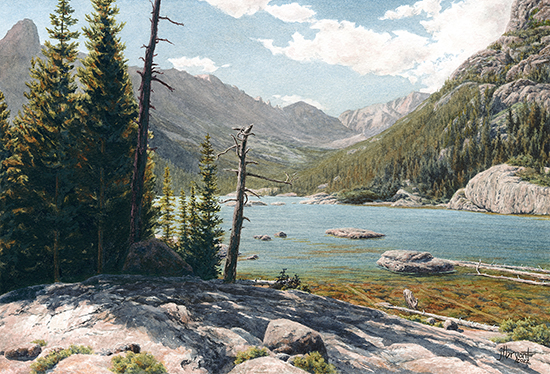
Going Beyond Best Intentions: How to Paint Outdoors Responsibly by Bob Bahr
Going Beyond Best Intentions:
How to Paint Outdoors Responsibly
by Bob Bahr

Jessica L. Bryant Painting on the Salmon River
We’re the good guys, right? We go out into nature, sometimes lugging our painting equipment into the backcountry, to paint scenes people may never witness in person. We bring the beauty of nature to those of us with few or no opportunities to explore the wonders of far-flung national and state parks. By doing so, we help to cultivate an appreciation for nature, and thus its conservation. We’re the good guys, right?
Yes, plein air painters help spread the gospel of nature’s beauty, but that doesn’t give us license to tread on the landscape without regard for best practices. In some ecosystems, even just walking on the ground alters the habitat, sometimes in profound ways.
Ever heard of cryptobiotic soil crusts? They are perhaps the best example of what can get hurt by even the best-intentioned plein air painter. In arid landscapes, the very top of the surface—we are talking millimeters deep here—develop a crust made by multiple organisms. (It can be thought of as a system similar to lichen, which is not a species but a symbiotic relationship between fungi and algae or bacteria.) This crust is crucial in preventing erosion. Remove the crust—and it can be destroyed by mere footsteps—and water and wind more easily wash away the silt that might be accumulating as part of the age-old cycle of desert turning into relatively arable land. It may be hard to view a desert landscape as a fragile ecosystem, with its hard-bitten plants, unforgiving rocks, and blowing sand, but it is.
The idea is not to ban humans from certain areas, but for the visiting humans to minimize their impact. The parks system helps by offering guidelines that may seem fussy at first, like telling us to stay on the trail. Painters like to step off the trail, both to get out of the way of foot traffic and to get just the right perspective on the subject matter. Think twice before doing so.

Merced River 10 x 13″ Watercolor © Jessica L. Bryant
Jessica L. Bryant paints in remote areas in national parks and in her home state of Idaho. She has held residencies in eight different national parks and has formed relationships with natural resource managers and park rangers. Her advice?
“The best thing is to familiarize yourself with Leave No Trace guidelines,” says the watercolorist. “Even if you are very familiar with the conservation rules for one area, they don’t necessarily apply to other areas. For example, in some parks, you are instructed to walk in a single file to minimize impact, while in Joshua Tree National Park, they want you to spread out, because that produces less damage to the ecosystem. You can argue that if it’s just me, there’s minimal impact. But it’s never just you; it just feels that way. There are so many people going out and enjoying the outdoors, including researchers and other artists. You can find human impact anywhere you go.”
The National Park Service offers seven Leave No Trace guidelines for visitors to wilderness areas and parks.
• Plan ahead and prepare. Research the area, prepare for weather, avoid high-traffic times and dates, repackage food to minimize waste, and use maps, compasses, or a GPS to avoid needing to mark trails with signs or cairns.
• Travel and camp on durable surfaces. This item is crucial for plein air painters. The idea is to set up on hard, smooth rock or an already trampled area.
• Pack out what you pack in. This includes trash, leftover food, and in some cases, human waste. Most painters are prepared to pack out their used supplies. If a painter isn’t comfortable with following park rules regarding human waste, then the painter is better off working in parks with toilet facilities. Water and other solvents should be packed out, not dumped on the ground.
• Leave what you find. Paint it, photograph it, admire it–but don’t pick it up or take it home. This includes rocks and plants.
• Minimize campfire impact. This usually doesn’t apply to plein air painters. But if you are camping overnight, read the NPS guidelines for fires.
• Respect wildlife. Observe from a distance, never feed animals, control your pets, store your food wisely.
• Be considerate of other visitors.
Read the full guidelines here.
We still hear some of you arguing that you are careful and you are doing good by emphasizing the beauty of the natural world, and taking it into people’s homes, putting it on their walls. But remember that when it comes to human behavior, it is often monkey see, monkey do.
“I know that people hiking will see me if I set up off trail, and that is going to be a subconscious visual cue as to what is acceptable,” Lynch says. “So I don’t stop on plant-covered, stressed areas. I find durable surfaces. I am looking for rocks. I’ll take a trail that steps over to a large rock outcropping. If I am not able to set up to paint a scene I’d like to paint without damaging the area, I’ll take a photo instead. That can be hard to do—to pass up a good vantage point for painting. But what’s more important, this one particular painting, or me—and others—being able to come back to the same place and see it the same way it looked that first time? When in doubt, err on the side of lightest impact.”

Afternoon at Mills Lake, Rocky Mountain National Park
9 x 13″ Watercolor © Jessica L. Bryant
All artwork copyright Jessica L. Bryant.
See more of Bryant’s work here: Jessica L. Bryant Watercolors
The Leave No Trace Guidelines for visitors to wilderness areas and parks.
Copyright Hulsey Trusty Designs, L.L.C. (except where noted). All rights reserved.
